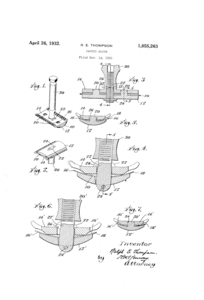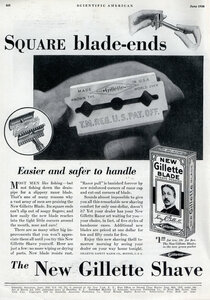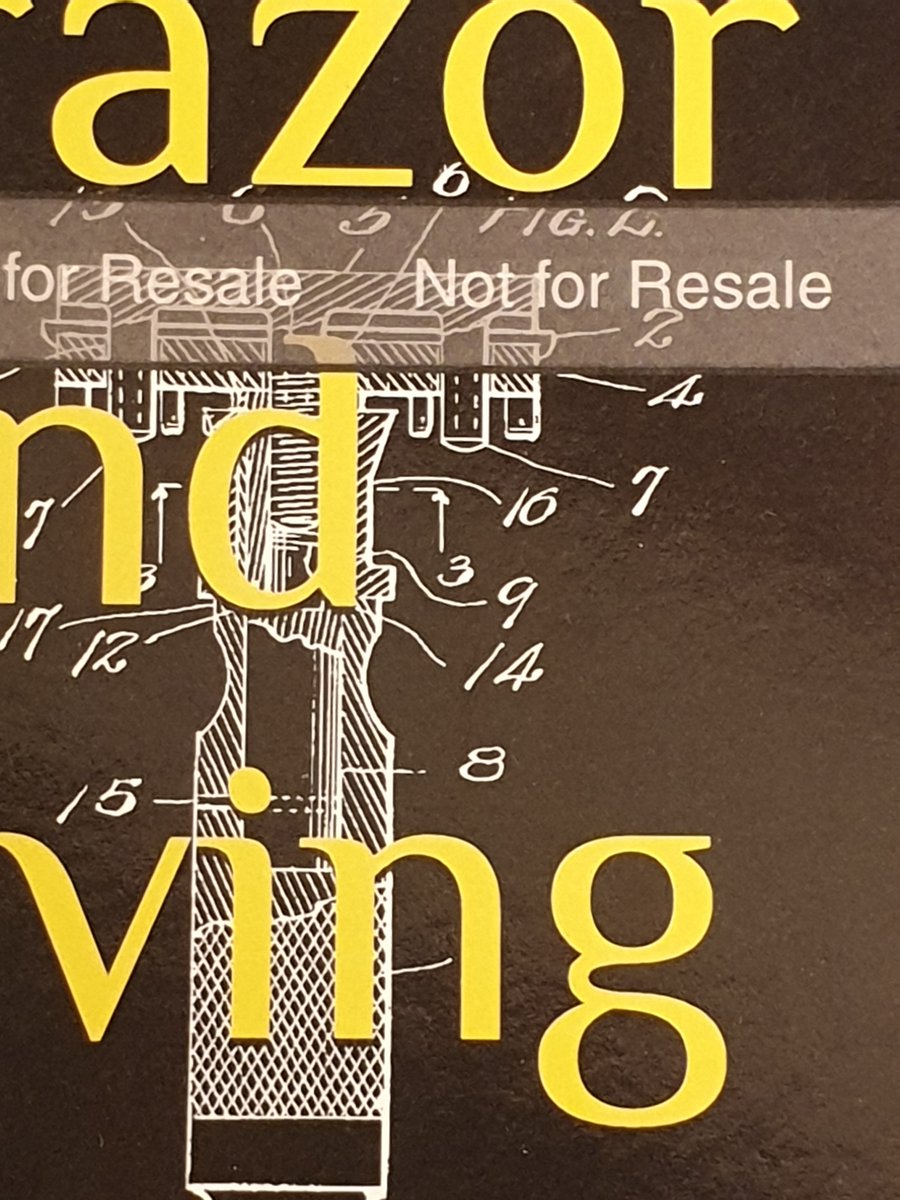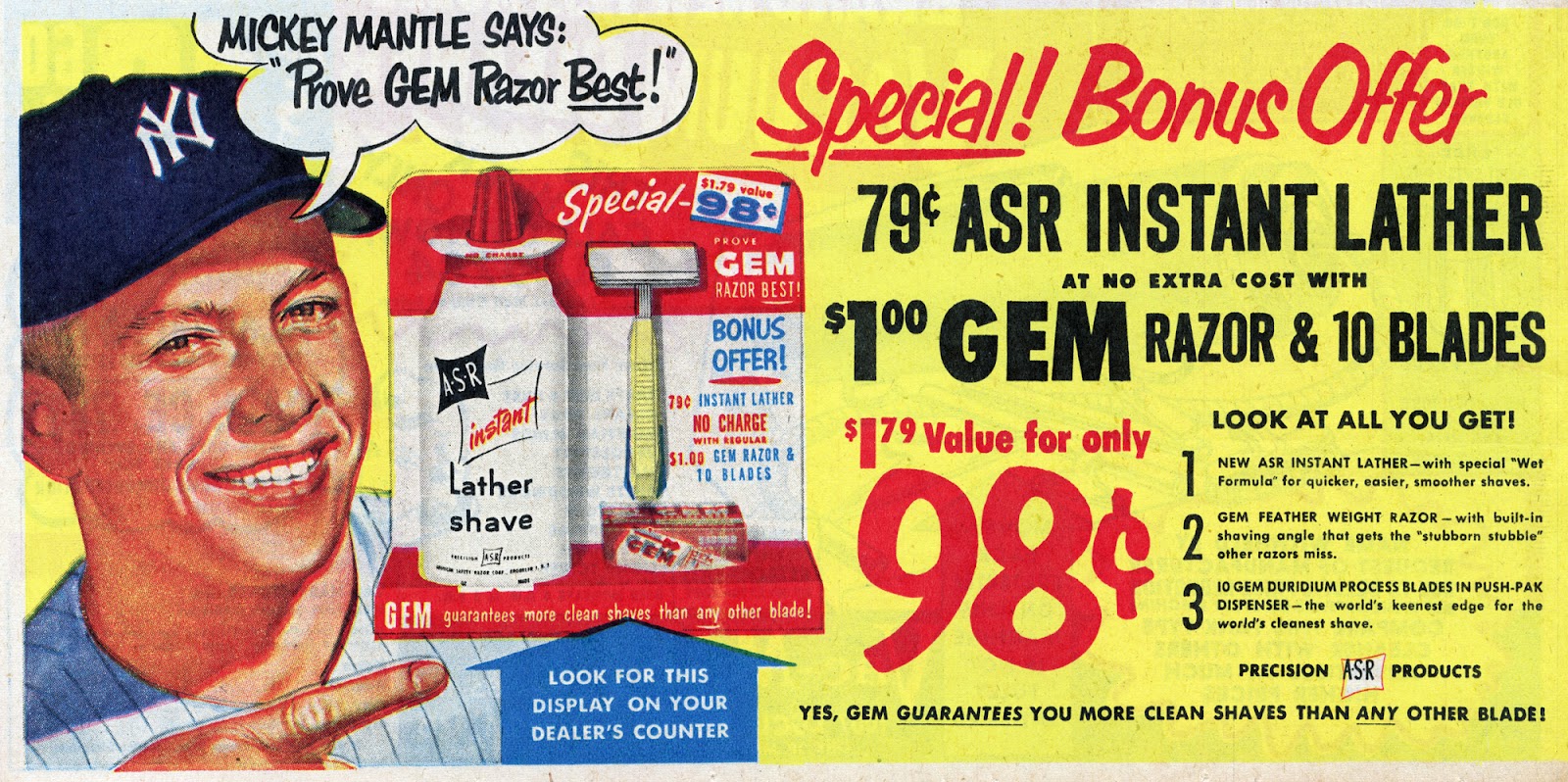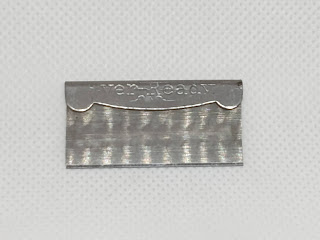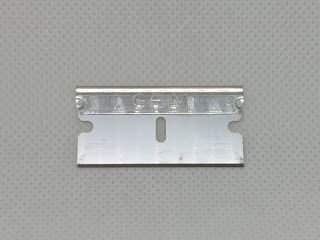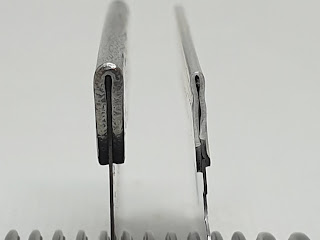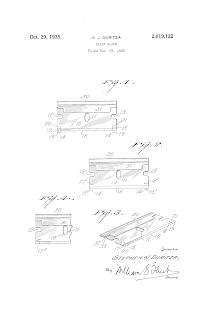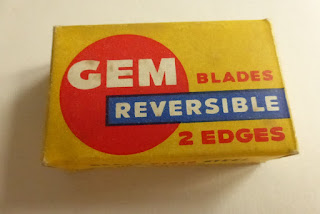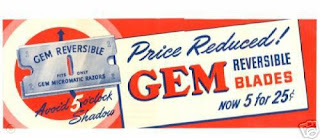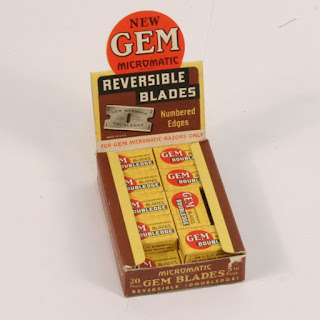I might have mentioned a few times – I’m excited, after all – that I’ve written a book on razor and shaving related patents… the Kindle edition is dropping on the 15th of March (you can preorder it now) and the paperback is now available too – so if you order it now, you’ll get it as early as the electronic version!
Tag Archives: Vintage
Ralph E Thompson and the amazing tilting adjustable razor
Ralph E Thompson was – as we’ve already seen – a rather prolific inventor of safety razors and associated gear, and he seems to have been one of the central characters in Gillette’s search for an improved, adjustable razor in the early 1930’s. As the preamble for the patent puts it:
This invention relates to safety razors, and more particularly to means for so adjusting the razor and blade as to vary the blade edge exposure thereof. Some beards require a considerable exposure of the blade edge if a satisfactory shave is to be secured while other beards require a much less exposure. The ideas of different people vary to a great extent in this matter and, furthermore, the same person may at one time desire a close shave and. at another time a rather rough shave.
So far so good; people have different ideas of how aggressive a razor should be, and people’s needs vary from day to day. Obvious for us today, who have grown up with adjustable razors, but in the context of the time it was perhaps less so. How Mr Thompson made the razor adjustable was very different than the methods we’re used today, and when adjusted it gave the shaver an aggressive and a mild edge to shave with.. useful, perhaps, in that you could do the first pass with one side and touch ups with the second.
In accordance with my invention, I so mount and preferably pivot a stud I to the cap that movement thereof causes such a relative transverse adjustment between the blade and guard as to. secure the said variations in blade exposure, the handle being adapted to cooperate with the stud to clamp the parts in the adjusted positions.
In the accompanying drawings I have illustrated certain specific embodiments of my invention but it, will be understood that the invention can be otherwise embodied and that the drawings are not to be construed as defining or limiting the scope of the invention.
So by tilting the base plate and cap in relation to the handle, the blade gap and blade exposure could be adjusted – as can be seen in figures 4 and 6 on the drawing. A potential improvement to Mr Thompson’s invention might be to flatten the very top of the cams (labelled as #32 in the drawings) slightly, so that the neutral position could easily be found.
The patents is – naturally – long since expired, and thus available if any daring razor manufacturer wishes to market out a truly unique, infinity variable adjustable razor that gives you a mild and aggressive shave at the same time.
Kindle edition of “70 razor and shaving patents” available for preorder
Today is a big day for me; today is the day that the kindle edition of my book 70 razor and shaving patents became available for preorder!
You can preorder it at http://getbook.at/70razor_shavingpatents – feel free to share to link to anyone interested. The official release date is March 15th 2020, and it will also be available in paperback.
New and useful Improvements in Safety-Razor-Blade Packages,
If your freshly invented razor relies on replaceable blades, you better come up with a way to pack the blades. And that goes double if your blades isn’t perfectly flat, such as the blades for the GEM and EverReady razors.
Enter Joseph Kaufman – of the American Safety Razor Corp – and the patent he filed in January 1907 for how to package a single edge razor blade with a spine. In hindsight the invention is obvious, but it was novel enough in 1907 to be granted a patent. In the words of the patent:
The combination with a safety razor blade having longitudinal shoulders, of a paper slip of much greater length than width and open at the top and having closed ends, the blade being inserted into the slip. the shoulders of the blade resting on the upper edges of the slip and the cutting edge of the blade being a short distance inward from the bottom edge of the slip, and an envelop surrounding the blade and slip, and a retaining and sealing band surrounding the envelop, substantially as set forth.
So in short; a paper wrap around the blade – making the blade as wide as the spine and protecting the edge – and a paper envelope around that.
I got some new-old-stock Radio Steel EverReady blades – inherited from a friend of the family as part of a EverReady 1914 kit – and those blades are packet exactly as the patent describes. And when I bought modern GEM blades loose – that is, not in a dispenser – they had the card-stock wrapper around the blade proper.
March 15th 2020…
Square blade ends
We might not think about it today, but those of us who uses vintage razors dating to before the mid 1930’s are actually using them with a blade they were not designed for – but the blade we’re using was designed to be compatible with them. And while the blade shown in this advertisement that ran in the June 1930 edition of Scientific American isn’t identical to the blade we know and love, it’s more than halfway there… Gillette just needed a lawsuit and a messy corporate merger with the American Safety Razor Company to get all the way there.
As an aside, this blade is probably the one covered by US patent US1850902A, filed in 1929. I might go into details on that at some point.
Comitting a book
When I asked a few months back on my favourite shave forum if I should “comitt” a book, the responce was positive… but there was also suggestions for not just making an annotated and commented version of the book I had in mind, but also to publish a collection of my posts discussing and snarking on old patents – solutions in search of a problems, blind roads on the road to the modern shave, but also good idea that simply failed to gain traction for one reason or another.
This is taking shape as a semi-curated selection of important, interesting, inessential, and plain odd shaving related patents – a somewhat serious, somewhat humorous little rump through the patent history of razor and other shaving related accoutrement, and lavishly illustrated with the original drawings from the patent applications and a handful of other pictures used to highlight points being discussed.
The proof copies of “70 razor and shaving patents” have now reached me. This means that if I don’t spot any typos, printing errors or other flaws, it’ll probably be released for sale before Easter.
It will be availabe for Kindle and as a print-on-demand paperback from Amazon. Prices are yet to be finalized… in part because I’m not sure what a good price would be for a 220 page, lavishly illustrated book.
A 1953 GEM advertisement
You can keep the can of goo, but I wouldn’t mind paying just shy of a dollar for a 1953 GEM with ten blades.
Adjusted for inflation, 98 cents would equal a little under ten dollars today. Not a bad deal all told – it’s about what you would have to pay for a modern multi-blade cartridge handle with a couple of cartridges today. Ten GEM blades should last longer than two modern carts though…
The invention of the modern GEM blade, with two interesting variations
The old vintage Ever-Ready and GEM razors from American Safety Razor Corp used a single edged blade different from the GEM blade we can buy today, as can be seen in the photos of one of my old unused – practically NOS – Ever-Ready blades and a fresh GEM blade from my stockpile.
As can clearly be seen the original Ever-Ready/GEM blade was thicker, with a much thicker spine, and had no cutouts. While you can use a modern blade in the original Ever-Ready and GEM razors – such as the 1912 and 19141 – you can’t use the original blade in a slightly more modern GEM, such as the various Micromatics. This is because the more modern razors uses the cutout to align the blade, and a blade without a cutout would stop the razor from closing properly.2
So logic dictates that the change in blade came about the same time as the GEM Micromatic was designed… Say hello to Marcus B Behrman’s patent filed and granted in 1929, describing not only what is in effect the modern GEM blade, but also the double edged single edged GEM blade I wrote about last week and a razor designed to utilise the new blade.
The invention aims primarily to provide a razor blade having special features of construction by the use of which the above mentioned adjustment of the blade with reference to the stops may be carried out with greater effectiveness and certainty, certain additional features of construction being preferably employed in the blade to insure that during assembly it will be preliminarily positioned within the proper range of action of the mechanism employed to press it against the stops.
The invention also includes a novel blade holder adapted to cooperate with a blade of the nature above referred to, to press the blade against the stops as aforesaid.
The function of, and the rationale behind, the cutouts in the blade – which was a radical departure from the original GEM blade – was quite well described in the patent:
To enable the blade to be effectively pressed against stops of the nature above referred to, I will provide it with cut-away portions and 26, located adjacent its opposite side or end edges and rearwardly of its shaving edge, these cut-away portions thereby presenting abutment shoulders 23 and 24 between t e cutaway portions and the shaving edge 20, which may be engaged by properly cooperating movable parts on a blade holder, to press the blade cutting edge against the stops on the holder as aforesaid.
The specific claims for the single and double edged variations of the blades were summarised as:
A safety razor blade having a shaving edge provided with stop engageable corner portions and cutaway portions in the central zone of the blade and in the opposite sides thereof, said cutaway portions presenting abutment shoulders therebetween and said shaving edge, said blade also having an opening between said cut-away portions with elongated linear side walls running transverse to said shaving edge to guide said stop engageable corner portions to their final predetermined stopping position.
A double edged safety razor blade having substantially parallel front and rear shaving edges provided with stop engageable corner portion, and cut-away portions adjacent opposite side edges which present abutment shoulders respectively spaced substantially equally from said front and rear edges, said blade also having an opening disposed substantially centrally between said cut-away portions, said opening being elongated in a direction transverse to said first mentioned edges and having end walls spaced substantially equally from the respective adjacent front and rear edges.
The form and function of the razor is also discussed at great length in the patent, but it’s mostly a variation on the previous GEM razors… the twist to open Micromatics must have been developed somewhat later.
As an interesting aside, a US patent filed for in 19303 also came to the surface as I was searching.
Filed by Stephen J Duritza, the preamble makes no secrets of which razor the new blade was meant for:
My present invention relates generally to razor blades and more particularly to the type of razor in which the shaving edge of the blade is to be received against front aligning stops to give such edge its predetermined position or relationship. Example of such type of razors are those known today as the “Gem” and the “Ever- Ready”.
Interestingly, the reason given for coming up with the new blade design wasn’t to simplify production, improve alignment, or give better shaves.. but to stop the corners from bending:
Where razors of this character are dropped on the floor or brought suddenly against a hard surface, it is generally the corners either of the blade seat or of the clamping cover where such clamping cover is employed, which receives the force of the impact, and may result in the bending of such corners. Where such bent corners engage the blade either at or adjacent to the shaving edge there may be the tendency in such a case for the shaving edge to be distorted from its true straight alignment for its most efficient shaving.
It is one of the objects of my invention to so arrange, treat or construct sections of the blade that this tendency to distortion under these conditions will be minimized or wholly eliminated.
Off course, not dropping your razor in the first place would been preferable – but if you do, it’s nice if you don’t have to replace the blade. What Mr Duritza did to avoid transmitting the shock of impact from the blade stops was to mechanically decouple the edge from the corners with a couple of slits. In the words of the patent:
If this fall results in a deformation of one of the aforementioned parts, this deformation would tend ordinarily to distort the non-functioning section of the shaving edge opposite thereto and this distortion would be transmitted to the active shaving edge. By providing the cuts 17 and 18 as hereinabove explained, the distortion will be taken up by the blade sections 20 or 21 as the case may be and will not be transmitted to the active shaving edge 16.
While the patent that gave rise to the modern GEM blade resulted in production that goes on to this day, Mr Duritza’s patent seems to have gone no where… perhaps the bending of the blade edge from dropping the razor was less of an issue than the inventor believed it to be? The Double Edged GEM blades also seems to have gone the way of the dinosaurs, sadly, but in the days before stainless blades I’m not too surprised about that – by the time you got to flip the blade over, the humidity and soap residue might have done a number on the second edge.
1) It will rattle a little until you close the razor, and a bit of care has to be taken – at least with my 1914 – to make sure it’s aligned properly.
2) This backward compatibility is similar to how you can use a modern slotted double edge blade in an original Gillette Old, but you can’t use a three holed blade in a Gillette Super Speed.
3) not granted until almost five years later though; the wheels of bureaucracy turns slowly at times.
The double edged single edged blade
Sounds like a contradiction in terms, but today I learned that GEM introduced a single edged blade in 1948 – although some sources states that it was sold during WW2 – that had two edges. Be basic idea was that you could flip it over once one edge was dull, in effect giving you two blades in one.
A little bit of searching on line has so far not revealed how they shaved, but the fact that they would only fit the Micromatics and we can’t get them no more seems to indicate that they wasn’t a run away success.


